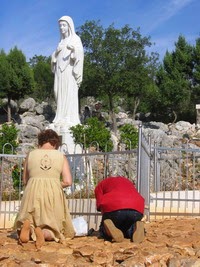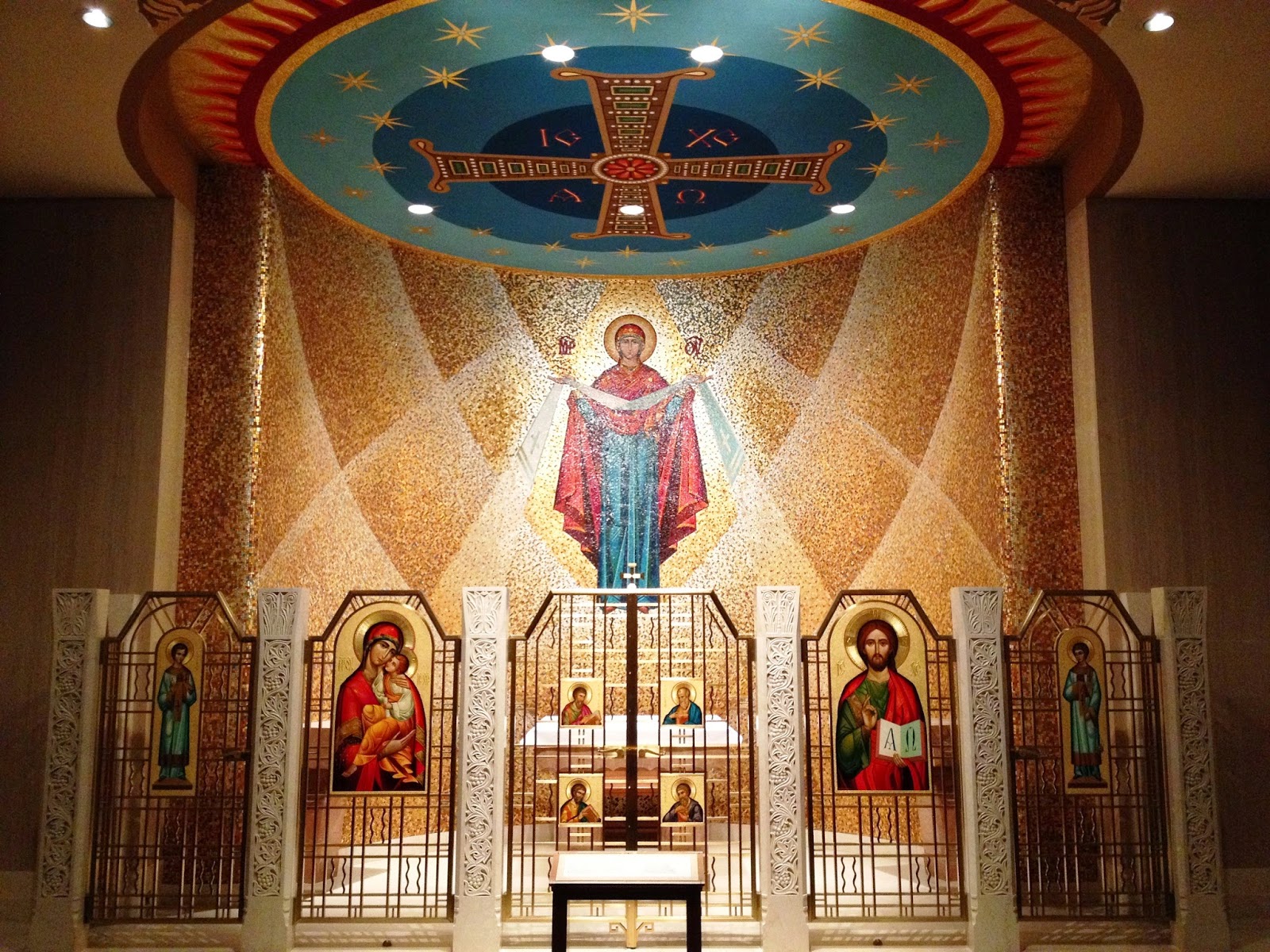So why do this? For two main reasons:
1. We are commanded in Proverbs to study our faith and grow in knowledge - "Let the wise hear and increase in learning, and the one who understands obtain guidance." (Proverbs 1:5)
2. We are called by Peter to, "always being prepared to make a defense to anyone who asks you for a reason for the hope that is in you; yet do it with gentleness and respect, having a good conscience..."
Knowing this then, it is important to put aside preconceptions about things you've heard through the grapevine, rumors, and/or blissful ignorance and crack open the Bible with a heart of contextual openness instead of bias. With that being said, let's move to the first common misconception.
____________________________
 The Evangelical Stance - Catholics (and some Episcopalians) have statues of people like Jesus, Mary, Joseph, and other saints long dead in their church and they bow before them, worship them, and pray to them. This is completely against the Ten Commandments, because the second commandment states, "You shall not make for yourself a graven image, or any likeness of anything that is in heaven above, or that is in the earth beneath, or that is in the water under the earth." (Ex. 20:4)
The Evangelical Stance - Catholics (and some Episcopalians) have statues of people like Jesus, Mary, Joseph, and other saints long dead in their church and they bow before them, worship them, and pray to them. This is completely against the Ten Commandments, because the second commandment states, "You shall not make for yourself a graven image, or any likeness of anything that is in heaven above, or that is in the earth beneath, or that is in the water under the earth." (Ex. 20:4) The Counter Argument - The first question that must be asked is simple: Can God get confused? ..... Of course, the answer is a resounding NO. Why ask that question? For this reason - if God is condemning absolutely the making of images and statues, then what other reason besides confusion (and possibly forgetfulness) would God have for commanding statues and images to be made? But God is not confused. And he certainly is not forgetful. So there must be more to this issue than meets the eye.
 Just five chapters later in Exodus 25:18-22 one who reads the second commandment in an absolute sense will be met with a major obstacle to their argument - God commands statues and images to be made to go on top of the Ark of the Covenant. But if God is against all carved images, why is he instructing them to be made? Cherubim, which are angels, are from heaven and are heavenly beings. Doesn't this fly in the face of the second commandment? One can also look to 1 Kings 6:23 (where God commands and blesses Solomon for filling the temple with statues and engraved figures and images), Numbers 21:8-9 (where God commands Moses to build a bronze serpent attached to a pole that had healing powers), and 1 Kings 6:29 (where King Solomon replicates through images and engraving the original Garden of Eden in the middle of his temple) which really seems to put God at odds with his own second commandment. But can that be?
Just five chapters later in Exodus 25:18-22 one who reads the second commandment in an absolute sense will be met with a major obstacle to their argument - God commands statues and images to be made to go on top of the Ark of the Covenant. But if God is against all carved images, why is he instructing them to be made? Cherubim, which are angels, are from heaven and are heavenly beings. Doesn't this fly in the face of the second commandment? One can also look to 1 Kings 6:23 (where God commands and blesses Solomon for filling the temple with statues and engraved figures and images), Numbers 21:8-9 (where God commands Moses to build a bronze serpent attached to a pole that had healing powers), and 1 Kings 6:29 (where King Solomon replicates through images and engraving the original Garden of Eden in the middle of his temple) which really seems to put God at odds with his own second commandment. But can that be?What then is God talking about in Exodus? He is prohibiting acts of natural idolatry. The word "graven" in Hebrew refers only to a very specific type of image - one made out of only stone or wood solely made to be worshipped. And in the culture of Moses, only the pagans practiced these types of graven idol worship. So God is speaking in a specific way for a specific culture in terms that they would understand immediately. God is prohibiting the worship of false pagan gods made out of these natural materials.
 At this point, from an academic standpoint, it should be reasoned without question that Catholics and Episcopalians are not guilty of idolatry because the statues and images in their churches are not false gods diametrically opposed to Christ himself, but are in fact aids that propel us deeper in our relationship with Christ.
At this point, from an academic standpoint, it should be reasoned without question that Catholics and Episcopalians are not guilty of idolatry because the statues and images in their churches are not false gods diametrically opposed to Christ himself, but are in fact aids that propel us deeper in our relationship with Christ. But even with that, some evangelists will counter the academic evidence with John 4:24 saying that these "aids" are still idolatrous because we, "must worship in spirit and truth." Again, the question must be, is Jesus confused or forgetful? The answer is still no. Evangelists would like to pigeonhole us into believing that John 4:24 must be in direct opposition to anything material. But not only does it not say or imply that, but there are many examples in the Bible that show worshipping in in the material sense is just as acceptable as worshipping in spirit and truth. We see the many examples in Solomon's temple (commanded and blessed by God himself) that refutes that claim. But we also can look to Numbers 15:38-39 where God commands his priests to wear special tassels so that their parishioners can, "look at and remember all the commandments of the Lord, to do them..." and in Genesis 9:13 where God uses the rainbow to create a materialistic sign of his invisible covenant with his chosen people. John 4:24 is not an either/or commandment. It is a both/and.

 And yes, we do bow down in front of statues. But is this idolatry? Absolutely not. In 1 Kings 2:19, King Solomon bows down to his mother when she enters in King's court. Is he worshipping her? No. He is showing her honor. The posture of bowing simply doesn't always denote worship and adoration. When a man proposes to his hopeful bride, he bows down before her on one knee. Is he worshipping her? No. He is showing her his honor and respect.
And yes, we do bow down in front of statues. But is this idolatry? Absolutely not. In 1 Kings 2:19, King Solomon bows down to his mother when she enters in King's court. Is he worshipping her? No. He is showing her honor. The posture of bowing simply doesn't always denote worship and adoration. When a man proposes to his hopeful bride, he bows down before her on one knee. Is he worshipping her? No. He is showing her his honor and respect.  Most evangelists who are quick to dismiss this practice of the veneration of images and statues in the Catholic and Episcopal church as outright idolatry, easily forget the images in their own stained glass windows, the Bible picture books and coloring books used in Sunday School classes, the live nativities and crèche scenes that are so abundant in their churches during the Christmas season, and the countless paintings of Christ himself that adorn so many pastors' studies and church hallways. If they absolutely believed Exodus 20:4, then they also are equally guilty of outright idolatry.
Most evangelists who are quick to dismiss this practice of the veneration of images and statues in the Catholic and Episcopal church as outright idolatry, easily forget the images in their own stained glass windows, the Bible picture books and coloring books used in Sunday School classes, the live nativities and crèche scenes that are so abundant in their churches during the Christmas season, and the countless paintings of Christ himself that adorn so many pastors' studies and church hallways. If they absolutely believed Exodus 20:4, then they also are equally guilty of outright idolatry.But here's the bottom line: in churches that understand the importance and the biblical precedence of incorporating material worship aids like statues, icons, and other sacred imagery into their church experience to get closer to Christ, they honor and show affection not for these images themselves but what they represent. And there is nothing idolatrous about that.

No comments:
Post a Comment